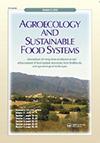Closing the Loop: Nutrient Balances in Organic and Conventional Coffee Agroforests
引用次数: 21
Abstract
Agroforests are a primary example of ecologically sustainable agroecosystems due to their efficient use of natural resources and ability to buffer against ecological and socioeconomic stresses. We constructed nitrogen (N) and phosphorus (P) balances to examine the ecological sustainability of conventional, organic, and unfertilized coffee agroforests. A similar percentage of applied nutrients were recovered in conventional and organic coffee yields. However, nutrient excess (inputs minus outputs) was higher in conventional farms, suggesting they may be more prone to nutrient loss. Nutrient pools were large overall, with unfertilized farms tending to store nutrients aboveground, and fertilized farms belowground. Future research should investigate the fate of excess nutrients to develop specific strategies promoting nutrient optimization in agroforests.闭合循环:有机和传统咖啡农林复合林中的营养平衡
农林复合林是生态可持续农业生态系统的一个主要例子,因为它们有效利用自然资源并有能力缓冲生态和社会经济压力。我们构建了氮(N)和磷(P)平衡来检验传统、有机和未施肥咖啡农林复合林的生态可持续性。在传统咖啡和有机咖啡产量中,施用的养分回收率相似。然而,传统农场的营养过剩(投入减去产出)更高,这表明它们可能更容易发生营养损失。总体而言,营养库很大,未施肥的农场倾向于将营养储存在地上,而施肥的农场倾向于将营养储存在地下。未来的研究应进一步研究过剩养分的去向,以制定促进农林业养分优化的具体策略。
本文章由计算机程序翻译,如有差异,请以英文原文为准。
求助全文
约1分钟内获得全文
求助全文

 求助内容:
求助内容: 应助结果提醒方式:
应助结果提醒方式:


